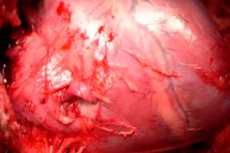Medical expert of the article
New publications
Pericardial adhesions
Last reviewed: 29.06.2025

All iLive content is medically reviewed or fact checked to ensure as much factual accuracy as possible.
We have strict sourcing guidelines and only link to reputable media sites, academic research institutions and, whenever possible, medically peer reviewed studies. Note that the numbers in parentheses ([1], [2], etc.) are clickable links to these studies.
If you feel that any of our content is inaccurate, out-of-date, or otherwise questionable, please select it and press Ctrl + Enter.

As a rule, pericardial adhesions develop against the background of inflammatory process in the pericardial area (pericarditis), against the background of chronic or recurrent pericarditis, after surgical operations. Often adhesions are detected in the process of diagnostics with the use of imaging methods absolutely accidentally, as they are asymptomatic. In some cases, the main symptoms are such phenomena as shortness of breath, palpitations, weakness, chills, which makes patients seek medical help. Also with the development of adhesions, the body temperature may rise. The condition is accompanied by pain, which is especially pronounced when changing position. In more severe cases, respiratory function is disturbed. In this case, the condition requires treatment.
In more severe cases, the formation of adhesions in the pericardium is accompanied by the accumulation of pathologic fluid. In case of adhesions formation, mandatory surgical treatment is performed, during which the adhesions are dissected. However, it should be taken into account that in this case, scars may remain.
Despite the fact that the operation for adhesions removal is considered simple, the postoperative period must be observed. Immediately after the operation, the patient is placed in a postoperative unit, and after a short time is transferred to the intensive care unit. After surgery, complications may occur. The most common complications include bleeding into the pleural cavity, the development of heart failure, the formation of pus, the development of purulent-septic process. After surgery, the patient is prescribed antibiotics, painkillers, cardiac drugs, as well as means aimed at improving blood circulation. On average, the duration of the recovery period (immediately after surgery) is 5-7 days. It takes about 2-3 months to fully restore the normal functional state of the heart. During this time, it is necessary to follow all the recommendations of the doctor, to control diet, drinking, to observe a certain level of physical activity.
In most cases, the prognosis is favorable. The pericardium heals, adhesions are removed. But scars may remain. Nevertheless, they are not life-threatening. There is a full restoration of the ability to work.

